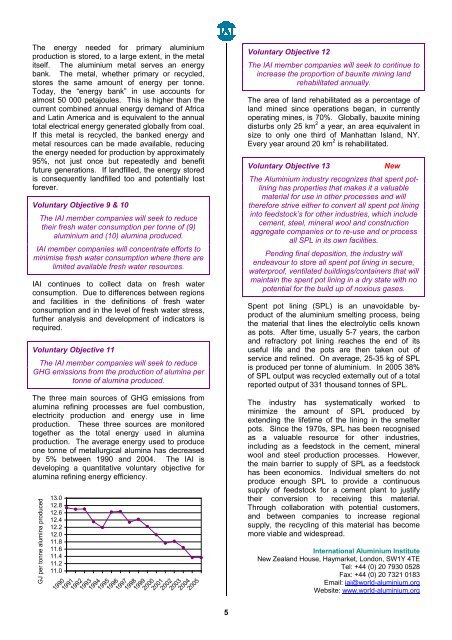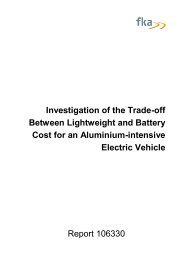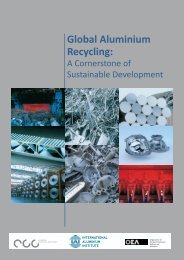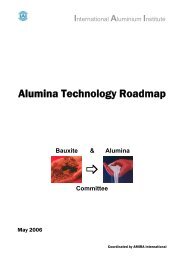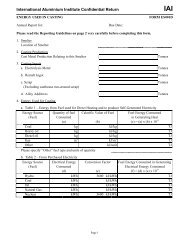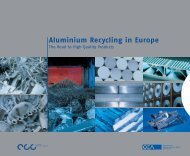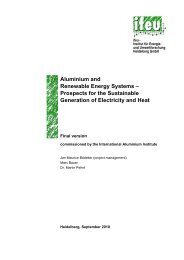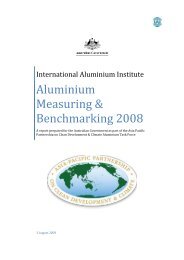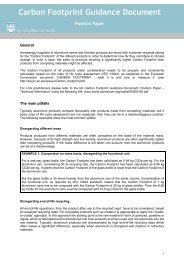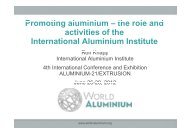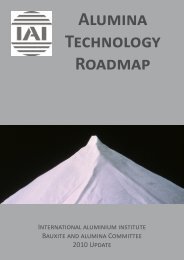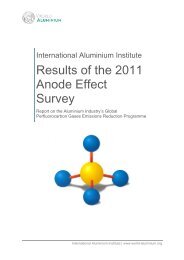aluminium for future generations sustainability update 2005
aluminium for future generations sustainability update 2005
aluminium for future generations sustainability update 2005
Create successful ePaper yourself
Turn your PDF publications into a flip-book with our unique Google optimized e-Paper software.
The energy needed <strong>for</strong> primary <strong>aluminium</strong><br />
production is stored, to a large extent, in the metal<br />
itself. The <strong>aluminium</strong> metal serves an energy<br />
bank. The metal, whether primary or recycled,<br />
stores the same amount of energy per tonne.<br />
Today, the “energy bank” in use accounts <strong>for</strong><br />
almost 50 000 petajoules. This is higher than the<br />
current combined annual energy demand of Africa<br />
and Latin America and is equivalent to the annual<br />
total electrical energy generated globally from coal.<br />
If this metal is recycled, the banked energy and<br />
metal resources can be made available, reducing<br />
the energy needed <strong>for</strong> production by approximately<br />
95%, not just once but repeatedly and benefit<br />
<strong>future</strong> <strong>generations</strong>. If landfilled, the energy stored<br />
is consequently landfilled too and potentially lost<br />
<strong>for</strong>ever.<br />
Voluntary Objective 9 & 10<br />
The IAI member companies will seek to reduce<br />
their fresh water consumption per tonne of (9)<br />
<strong>aluminium</strong> and (10) alumina produced.<br />
IAI member companies will concentrate ef<strong>for</strong>ts to<br />
minimise fresh water consumption where there are<br />
limited available fresh water resources.<br />
IAI continues to collect data on fresh water<br />
consumption. Due to differences between regions<br />
and facilities in the definitions of fresh water<br />
consumption and in the level of fresh water stress,<br />
further analysis and development of indicators is<br />
required.<br />
Voluntary Objective 11<br />
The IAI member companies will seek to reduce<br />
GHG emissions from the production of alumina per<br />
tonne of alumina produced.<br />
The three main sources of GHG emissions from<br />
alumina refining processes are fuel combustion,<br />
electricity production and energy use in lime<br />
production. These three sources are monitored<br />
together as the total energy used in alumina<br />
production. The average energy used to produce<br />
one tonne of metallurgical alumina has decreased<br />
by 5% between 1990 and 2004. The IAI is<br />
developing a quantitative voluntary objective <strong>for</strong><br />
alumina refining energy efficiency.<br />
GJ per tonne alumina produced<br />
13.0<br />
12.8<br />
12.6<br />
12.4<br />
12.2<br />
12.0<br />
11.8<br />
11.6<br />
11.4<br />
11.2<br />
11.0<br />
1990<br />
1991<br />
1992<br />
1993<br />
1994<br />
1995<br />
1996<br />
1997<br />
1998<br />
1999<br />
2000<br />
2001<br />
2002<br />
2003<br />
2004<br />
<strong>2005</strong><br />
5<br />
Voluntary Objective 12<br />
The IAI member companies will seek to continue to<br />
increase the proportion of bauxite mining land<br />
rehabilitated annually.<br />
The area of land rehabilitated as a percentage of<br />
land mined since operations began, in currently<br />
operating mines, is 70%. Globally, bauxite mining<br />
disturbs only 25 km 2 a year, an area equivalent in<br />
size to only one third of Manhattan Island, NY.<br />
Every year around 20 km 2 is rehabilitated.<br />
Voluntary Objective 13<br />
New<br />
The Aluminium industry recognizes that spent potlining<br />
has properties that makes it a valuable<br />
material <strong>for</strong> use in other processes and will<br />
there<strong>for</strong>e strive either to convert all spent pot lining<br />
into feedstock’s <strong>for</strong> other industries, which include<br />
cement, steel, mineral wool and construction<br />
aggregate companies or to re-use and or process<br />
all SPL in its own facilities.<br />
Pending final deposition, the industry will<br />
endeavour to store all spent pot lining in secure,<br />
waterproof, ventilated buildings/containers that will<br />
maintain the spent pot lining in a dry state with no<br />
potential <strong>for</strong> the build up of noxious gases.<br />
Spent pot lining (SPL) is an unavoidable byproduct<br />
of the <strong>aluminium</strong> smelting process, being<br />
the material that lines the electrolytic cells known<br />
as pots. After time, usually 5-7 years, the carbon<br />
and refractory pot lining reaches the end of its<br />
useful life and the pots are then taken out of<br />
service and relined. On average, 25-35 kg of SPL<br />
is produced per tonne of <strong>aluminium</strong>. In <strong>2005</strong> 38%<br />
of SPL output was recycled externally out of a total<br />
reported output of 331 thousand tonnes of SPL.<br />
The industry has systematically worked to<br />
minimize the amount of SPL produced by<br />
extending the lifetime of the lining in the smelter<br />
pots. Since the 1970s, SPL has been recognised<br />
as a valuable resource <strong>for</strong> other industries,<br />
including as a feedstock in the cement, mineral<br />
wool and steel production processes. However,<br />
the main barrier to supply of SPL as a feedstock<br />
has been economics. Individual smelters do not<br />
produce enough SPL to provide a continuous<br />
supply of feedstock <strong>for</strong> a cement plant to justify<br />
their conversion to receiving this material.<br />
Through collaboration with potential customers,<br />
and between companies to increase regional<br />
supply, the recycling of this material has become<br />
more viable and widespread.<br />
International Aluminium Institute<br />
New Zealand House, Haymarket, London, SW1Y 4TE<br />
Tel: +44 (0) 20 7930 0528<br />
Fax: +44 (0) 20 7321 0183<br />
Email: iai@world-<strong>aluminium</strong>.org<br />
Website: www.world-<strong>aluminium</strong>.org


